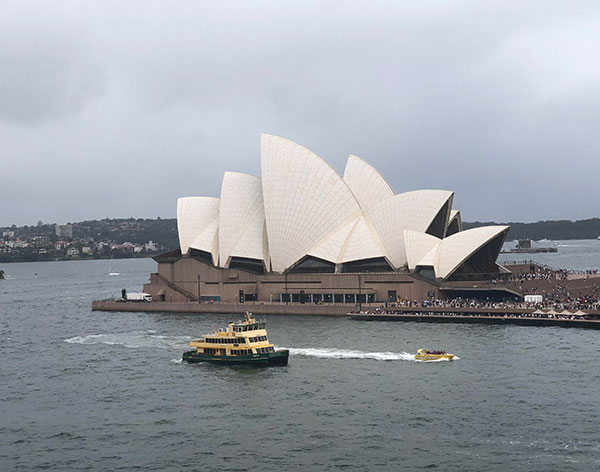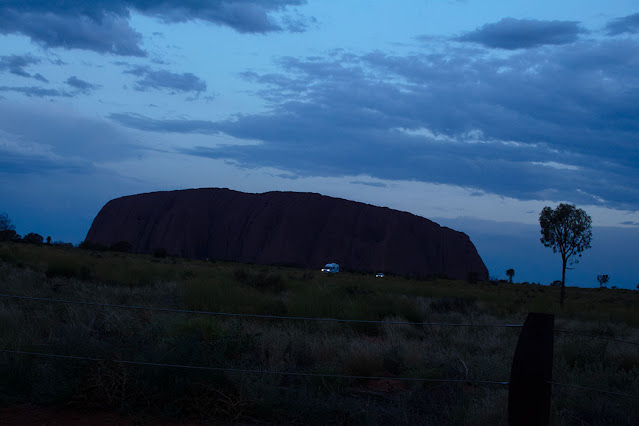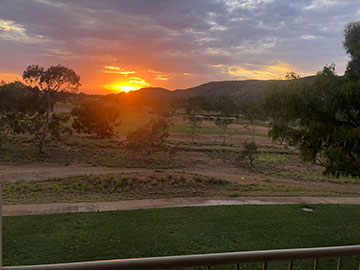Greetings from Palmia Observatory,
Well, we are back from our cruise adventure to the Southern Hemisphere with ports of call in New Zealand and Australia with an add on adventure into the outback of Australia. We were also lucky in travelling with old friends, OC Astronomers and Radio Hams, Marty and Bonnie.
Anyway, we are late in wishing everyone a happy new year. So, Happy New Year everyone! There was a lot of celebration aboard the ship, but we were tired out and missed actual new year's by about 3 hours.
 |
| Resident Astronomers say Happy New Year Everyone! (Source: Palmia Observatory) |
We joined our cruise ship in Auckland, New Zealand and then after some days of sailing celebrated Christmas at sea off the coast of New Zealand on the way to Tasmania. Here we are at the bottom of the grand staircase in front of the Christmas trees.
 |
| Celebrating Christmas aboard Viking Orion off the New Zealand coast (Source: Palmia Observatory) |
Now we had hoped to be able to get some views of the night sky from the Southern Hemisphere, but it was mostly cloudy and overcast with just a patch or two of clear sky. The Viking Orion cruise ship had a resident astronomer on board, Dr. Charles Lineweaver, who conducted a few observing attempts under cloudy skies. Many of us physicist Wannabes are familiar with Dr. Lineweaver from our studies of calculating the entropy of the universe so it was nice to meet him.
We didn't bring a telescope, only a DSLR and flimsy tripod, but Resident Astronomer Peggy managed to look around with shipboard telescope.
 |
| Resident Astronomer tries observing aboard Viking Orion (Source: Palmia Observatory) |
One of the things we liked about being onbaord was all the great food. It was nice to enjoy eating a great meal and just watching the sea go by.
 |
| Resident Astronomers enjoy dinner (and martinis) at sea (Source: Palmia Observatory) |
Our first stop after Hobart in Tasmania was the mainland Australian city of Melbourne, where we saw the local sites and visited the Melbourne Zoo. We had hoped to see the New Year fireworks celebration in Sydney, but it turned out we were still out at sea at midnight and were only able to get to Sydney on New Years Day. We just sailed passed the Sydney Opera House and didn't have any time to get inside.
 |
| Leaving the cruise in Sydney for Australian outback adventure (Source: Palmia Observatory) |
So we disembarked our cruise ship after a day of sightseeing in Sydney and a rest stop at Bondi Beach and hoped on a plane for the flight to the Australian outback. Our first stop there was Ayers Rock Resort, home of the Ayer's Rock, or Uluru as it is called in the aboriginal language.
We still had some time to review more of Dr. Lineweaver's discussion of "Complexity and the Arrow of Time." We read that gravity is the main source of complexity in that the gravitational collapse of big bang hot gas results in clumpy galaxies and solar systems.
 |
| Reading Dr. Charlie's book with help from my martini friend (Source: Palmia Observatory) |
We had hoped that the outback, given that it is mostly a dry desert type environment, that we would have cloud free nights for observing. But no, the clouds and some rain interfered with that. We had one great night out while at a barbeque event on the outskirts of Alice Springs and the sponsors turned off all the lights and we were almost blinded by the number of visible stars. We didn't bring the DSLR but so enjoyed just seeing so many stars. But any hopes of seeing the LMC and SMC were dashed by lots of clouds in that area of the sky.
Back at the hotel, I grabbed the DSLR and just did a 15-second handheld exposure of the night sky overlooking a golf course from our hotel room. Hmm, just as you can see there are not stars visible through all the clouds.
 |
| Clouds and more clouds in this 15 second, DSLR night sky image (Source: Palmia Observatory) |
We had scheduled two observing events around that big darn rock, Uluru, for sunrise viewing and for sunset viewing. Both events were mostly clouded out and no sunlight streaming over the rock could be seen.
As you can see in this image of Uluru, if it had not been for my astronomy app showing the sunrise, and sunset in this case, you would not be able to tell that the sun was above the horizon. It was still impressive and very enjoyable to be there.
 |
| Even sunset at Uluru was clouded out (Source: Palmia Observatory) |
We finally did capture an image of sunrise from our Alice Springs hotel even with a lot of clouds.
 |
| Sunrise in Alice Springs with clouds (Source: Palmia Observatory) |
We managed to see some wildlife on our adventure, like wallabies, but no Kiwi in New Zealand or Koala bears either, so we had to suffice with some stuffed versions of the native animals when we got back to the Observatory. Astronomer Assistant Ruby was maybe a bit depressed about being replaced, but we quickly let her know that that was not the case.
 |
| We didn't see any of our new Kiwi and Koala friends (Source: Palmia Observatory) |
Well, we were a bit jet lagged after crossing the international date line and returning to Observatory, but I still managed to find a more stable and suitable microscope to continue with our search for actual water bears. Our friends at Amazon had a great little digital microscope for $398, which was quite cheap compared with some astronomy type tools.
Anyway, we hope to continue in our search and will have to take off our astronomer wannabe hat and replace it with a microbiologist wannabe hat for a week or two.
 |
| Selected this digital microscope for Water Bear search (Source: Amazon.com) |
Well, the microscope showed up at the Observatory receiving dock and even in my still jet lagged mind was able to set it up and power it up. The first light through the microscope just shows some dirt or something on the lens or illumination bulb.
So, stay tuned for our ongoing adventure in microscopy! If you missed the connection with water bears or tardigrades, check out our previous blog post of December 15, 2023 at: http://www.palmiaobservatory.com/2023/12/resident-astronomer-tries-his-hand-at.html
 |
| First light through new microscope (Source: Palmia Observatory) |
Until next time,
Resident Astronomer George

No comments:
Post a Comment